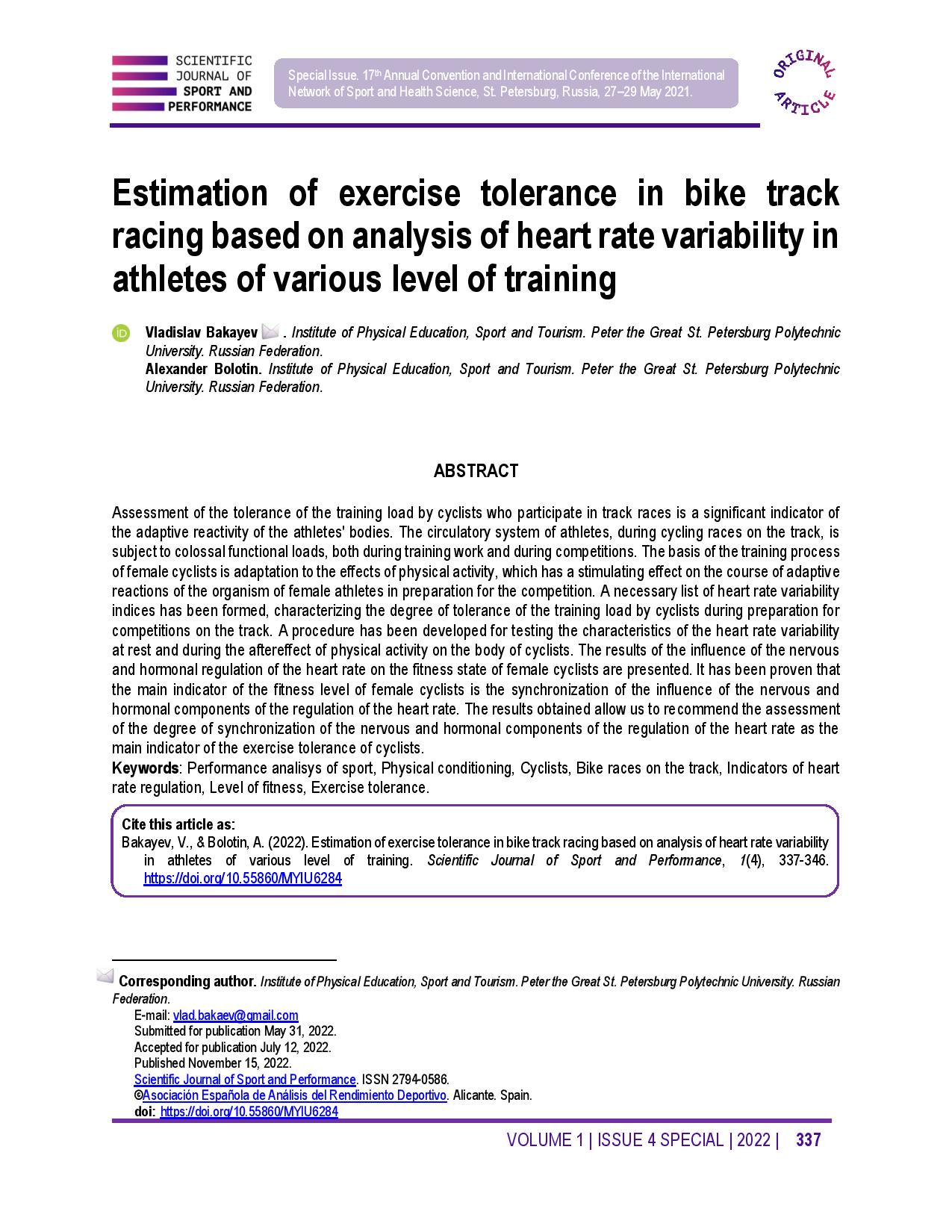Estimation of exercise tolerance in bike track racing based on analysis of heart rate variability in athletes of various level of training
Main Article Content
Abstract
Assessment of the tolerance of the training load by cyclists who participate in track races is a significant indicator of the adaptive reactivity of the athletes' bodies. The circulatory system of athletes, during cycling races on the track, is subject to colossal functional loads, both during training work and during competitions. The basis of the training process of female cyclists is adaptation to the effects of physical activity, which has a stimulating effect on the course of adaptive reactions of the organism of female athletes in preparation for the competition. A necessary list of heart rate variability indices has been formed, characterizing the degree of tolerance of the training load by cyclists during preparation for competitions on the track. A procedure has been developed for testing the characteristics of the heart rate variability at rest and during the aftereffect of physical activity on the body of cyclists. The results of the influence of the nervous and hormonal regulation of the heart rate on the fitness state of female cyclists are presented. It has been proven that the main indicator of the fitness level of female cyclists is the synchronization of the influence of the nervous and hormonal components of the regulation of the heart rate. The results obtained allow us to recommend the assessment of the degree of synchronization of the nervous and hormonal components of the regulation of the heart rate as the main indicator of the exercise tolerance of cyclists.
Article Details

This work is licensed under a Creative Commons Attribution-NonCommercial-ShareAlike 4.0 International License.
References
Bakayev, V., Bolotin, A., & You, C. (2018). Reaction of vegetative nervous system to loads in female long-distance runners with different fitness level. Journal of Human Sport and Exercise, 13(2proc), S245-S252. doi: https://doi.org/10.14198/jhse.2018.13.Proc2.09 DOI: https://doi.org/10.14198/jhse.2018.13.Proc2.09
Bakayev, V. (2015). Determining the significance of practical military skills applied by the special purpose regiments of the Internal Troops of the Russian Ministry of Internal Affairs to deliver combat objectives. Journal of Physical Education and Sport, 15(4), pp. 615-618.
Barcelos LC, Nunes PR, de Souza LR, de Oliveira AA, Furlanetto R, Marocolo M, Orsatti FL (2015). Low-load resistance training promotes muscular adaptation regardless of vascular occlusion, load, or volume. Eur J Appl Physiol., 115(7):1559–1568 DOI: https://doi.org/10.1007/s00421-015-3141-9
Begum, N. (2016). Analysis of heart rate variability. Bangabandhu Sheikh Mujib Medical University Journal, 6(2), 84. https://doi.org/10.3329/bsmmuj.v6i2.29120 DOI: https://doi.org/10.3329/bsmmuj.v6i2.29120
Bolotin A, Bakayev V. (2017a). Peripheral circulation indicators in veteran trail runners. Journal of Physical Therapy Science, 29: 1092–1094. DOI:10.1589/jpts.29.1092 DOI: https://doi.org/10.1589/jpts.29.1092
Bolotin A., Bakayev V. (2017b). The differences in response of the respiratory system of long and middle-distance runners and their influence on recovery rate. Journal of Physical Education and Sport, 17(4), pp.2443-2446. DOI: 10.7752/jpes.2017.04272 DOI: https://doi.org/10.7752/jpes.2017.04272
Bunevicius, K, Sujeta A, Poderiene K, et al. (2016). Cardiovascular response to bouts of exercise with blood flow restriction. Journal of Physical Therapy Science, 29(12), 3288-3292. https://doi.org/10.1589/jpts.28.3288 DOI: https://doi.org/10.1589/jpts.28.3288
Bilan, A.; Witczak, A.; Palusinski, R.; Myslinski, W.; Hanzlik, J. (2005). Circadian rhythm of spectral indices of heart rate variability in healthy subjects. J. Electrocardiol., 38, 239–243. DOI: https://doi.org/10.1016/j.jelectrocard.2005.01.012
Cooper, K (1989). The aerobics program for total well-being. Physical Education and Sport, Moscow, 224 p.
Daniel, S. (2009). Abnormal blood flow in the sublingual microcirculation at high altitude. Eur. J. Appl. Physiol., (106), 473-478. DOI: https://doi.org/10.1007/s00421-009-1023-8
Flatt, A.A.; Esco, M.R. (2015). Smartphone-Derived Heart-Rate Variability and Training Load in a Women’s Soccer Team. Int. J. Sports Physiol. Perform., 10, 994–1000. DOI: https://doi.org/10.1123/ijspp.2014-0556
Hopkins, W.G.; Marshall, S.W.; Batterham, A.M.; Hanin, J. (2009). Progressive statistics for studies in sports medicine and exercise science. Med. Sci. Sports Exerc., 41, 3–13. DOI: https://doi.org/10.1249/MSS.0b013e31818cb278
Kaikkonen, P.; Hynynen, E.; Mann, T.; Rusko, H.; Nummela, A. (2012). Heart rate variability is related to training load variables in interval running exercises. Eur. J. Appl. Physiol., 112, 829–838. DOI: https://doi.org/10.1007/s00421-011-2031-z
Manso, J.M. (2013). Application of Heart Rate Variability in sports training control: Frequency mode analysis. Archivos de Medicina del Deporte. 30. 43-51.
Plews, D.J.; Laursen, P.B.; Kilding, A.E.; Buchheit, M. (2012). Heart rate variability in elite triathletes, is variation in variability the key to effective training? A case comparison. Eur. J. Appl. Physiol., 112, 3729–3741. DOI: https://doi.org/10.1007/s00421-012-2354-4
Reena Tiwari, Ravindra Kumar, Sujata Malik, Tilak Raj and Punit Kumar (2021). Analysis of Heart Rate Variability and Implication of Different Factors on Heart Rate Variability. Current Cardiology Reviews, 17(5). https://doi.org/10.2174/1573403X16999201231203854 DOI: https://doi.org/10.2174/1573403X16999201231203854
Reimers, A.K.; Knapp, G.; Reimers, C.-D. (2018). Effects of Exercise on the Resting Heart Rate: A Systematic Review and Meta-Analysis of Interventional Studies. J. Clin. Med., 7, 503. DOI: https://doi.org/10.3390/jcm7120503
Stanley, J.; Peake, J.M.; Buchheit, M. (2013). Cardiac parasympathetic reactivation following exercise: Implications for training prescription. Sports Med., 43, 1259–1277 DOI: https://doi.org/10.1007/s40279-013-0083-4




